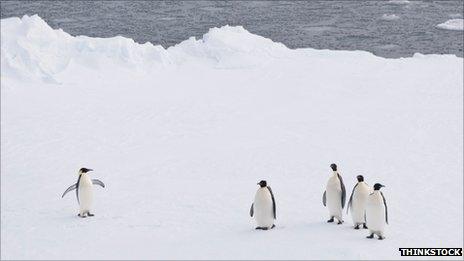Who, what, why: How do you release animals back into the wild?
- Published

Happy Feet, a "lost" penguin washed up in New Zealand, has been returned to the ocean. So how do you release an animal back into the wild?
The plight of an injured wild animal is always poignant. But sometimes there's a happy ending - a creature nurtured back to health by humans and then released into the wild.
Such is the case with Happy Feet, the Emperor penguin washed up on a New Zealand beach two months ago. He was more than 1,800 miles from his home in Antarctica and needed surgery after consuming 3kg of sand. Experts believe it may have mistaken the sand for snow.
The bird recovered well from surgery and at the weekend was released from a research vessel into the Southern Ocean to begin the long swim south.
Animals are regularly being released into the wild. If the animal is injured it's important to treat it quickly so that it can be released back into the wild without becoming dependent on humans. In the case of an injured tiger it will be put in a pen and given food, but not handled.
High-tech rehabilitation is now common. Happy Feet would have been fed with tubes and given antifungals and antibiotics, says Romain Pizzi, a veterinary surgeon at the Royal Zoological Society of Scotland.
Once he'd recovered, he swam in salt water cooled to 0C. Such a test would show whether he was too thin for cold water and if his feathers were waterproof.
It's not only exotic species who benefit. A fox recently found in Yorkshire suffering from a broken hip was given treatment in a hydrotherapy pool. The vet, John Levinson, says the intention was to get it fit enough to return to the wild.
Some species are more able to be helped than others. There have been successful campaigns to release cheetahs and leopards in Namibia and elephants in Kenya and Sri Lanka. But other species like polar bears are more difficult, says Ian Redmond, a consultant to the Born Free Foundation.
"Once a polar bear gets used to captivity it's very hard to re-release it because it won't learn how to hunt and survive," he says.
Orphaned animals are another difficult group. Leave them too long in captivity and they will never be able to return to the wild. With polar bears there is the opportunity to place them with mother bears who only have one cub.
"The reason we try to adopt them out is because the learning they get while being dependent on their mothers can't be replaced. It's a critical year," says Redmond.
More difficult is rearing an animal in captivity and later releasing it into the wild. The Chinese ran a successful breeding programme for giant pandas, says Mark Wright, science advisor to the World Wildlife Fund. But the project has failed to properly integrate them into their natural habitat.
"One of them got severely mauled by another panda because it wasn't used to competition for territory," he says.
The key thing is to understand the skills the animal needs to survive in the wild. And then to try and impart those skills to the creature before setting it free. Even getting this right is pointless if the habitat is too small or if there is poaching going on, Wright warns.
"There's no point releasing it if someone is going to come and shoot it two days later."
Finally, there is the case of reintroducing a species that has died out. The RSPB has successfully done this with red kites and sea eagles across parts of the UK.
But such programmes cause controversy. The Scottish Gamekeepers Association recently asked whether a sea eagle will be able to differentiate between a "small child" and "natural quarry".
Pizzi says Happy Feet has made an "impressive" recovery. "He must have been very ill. To be lying down and not scarpering with people approaching shows he wasn't well."
It's hard to say how he will do. There is a wealth of research to show that penguins like the African black-footed penguin, common to Cape Town, thrive after rehabilitation.
But very little is known about the Emperor penguins, which breed only on the Antarctic peninsula. It's worth a try, Pizzi says.
"I think he's got a reasonable chance," he says. And the alternative of a life in captivity, would be far worse. "This is a wild animal. There's no point keeping him in a zoo."